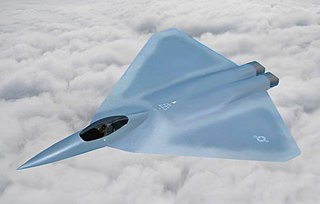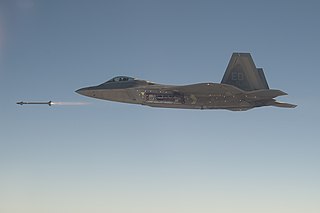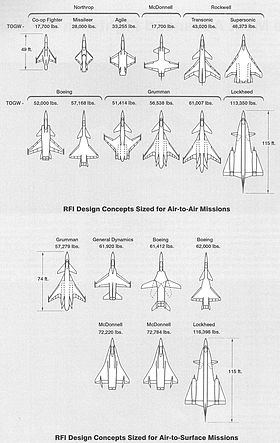
The Lockheed F-117 Nighthawk is a retired American single-seat, subsonic twin-engine stealth attack aircraft developed by Lockheed's secretive Skunk Works division and operated by the United States Air Force (USAF). It was the first operational aircraft to be designed with stealth technology.

The Lockheed Martin/Boeing F-22 Raptor is an American single-seat, twin-engine, supersonic all-weather stealth fighter aircraft developed for the United States Air Force (USAF). As a product of the USAF's Advanced Tactical Fighter (ATF) program the aircraft was designed as an air superiority fighter, but also incorporates ground attack, electronic warfare, and signals intelligence capabilities. The prime contractor, Lockheed Martin, built most of the F-22's airframe and weapons systems and conducted final assembly, while program partner Boeing provided the wings, aft fuselage, avionics integration, and training systems.
Supercruise is sustained supersonic flight of a supersonic aircraft without using afterburner. Many supersonic military aircraft are not capable of supercruise and can maintain Mach 1+ flight only in short bursts with afterburners. Aircraft such as the SR-71 Blackbird are designed to cruise at supersonic speed with afterburners enabled.

The fourth-generation fighter is a class of jet fighters in service from around 1980 to the present, and represents design concepts of the 1970s. Fourth-generation designs are heavily influenced by lessons learned from the previous generation of combat aircraft. Third-generation fighters were often designed primarily as interceptors, being built around speed and air-to-air missiles. While exceptionally fast in a straight line, many third-generation fighters severely lacked in maneuverability, as doctrine held that traditional dogfighting would be impossible at supersonic speeds. In practice, air-to-air missiles of the time, despite being responsible for the vast majority of air-to-air victories, were relatively unreliable, and combat would quickly become subsonic and close-range. This would leave third-generation fighters vulnerable and ill-equipped, renewing an interest in manoeuvrability for the fourth generation of fighters. Meanwhile, the growing costs of military aircraft in general and the demonstrated success of aircraft such as the McDonnell Douglas F-4 Phantom II gave rise to the popularity of multirole combat aircraft in parallel with the advances marking the so-called fourth generation.

The Northrop/McDonnell Douglas YF-23 is an American single-seat, twin-engine, supersonic stealth fighter aircraft technology demonstrator designed for the United States Air Force (USAF). The design was a finalist in the USAF's Advanced Tactical Fighter (ATF) competition, battling the Lockheed YF-22 for a production contract. Two YF-23 prototypes were built.

The Lockheed Martin X-44 MANTA was an American conceptual aircraft design by Lockheed Martin that has been studied by NASA and the U.S. Air Force. It was intended to test the feasibility of full yaw, pitch and roll authority without tailplanes. Attitude control relies purely on 3D thrust vectoring. The aircraft design was derived from the F-22 Raptor and featured a stretched delta wing without tail surfaces.

The Pratt & Whitney F119, company designation PW5000, is an afterburning turbofan engine developed by Pratt & Whitney for the Advanced Tactical Fighter (ATF) program, which resulted in the Lockheed Martin F-22 Raptor. The engine delivers thrust in the 35,000 lbf (156 kN) class and was designed for sustained supersonic flight without afterburners, or supercruise. Delivering almost 22% more thrust with 40% fewer parts than its F100 predecessor, the F119 allows the F-22 to achieve supercruise speeds of up to Mach 1.8. The F119's nozzles incorporate thrust vectoring that enable them to direct the engine thrust ±20° in the pitch axis to give the F-22 enhanced maneuverability.

The Lockheed/Boeing/General Dynamics YF-22 is an American single-seat, twin-engine fighter aircraft technology demonstrator designed for the United States Air Force (USAF). The design was a finalist in the USAF's Advanced Tactical Fighter competition, and two prototypes were built for the demonstration/validation phase of the competition. The YF-22 won the contest against the Northrop YF-23, and the design was developed into the Lockheed Martin F-22 Raptor. The YF-22 has a similar aerodynamic layout and configuration as the F-22, but with differences in the position and design of the cockpit, tail fins and wings, and in internal structural layout.
The Lockheed Martin FB-22 was a proposed stealth bomber aircraft marketed to the United States Air Force. Its design was derived from the F-22 Raptor. Lockheed Martin proposed its unsolicited design as a "regional bomber" to complement the aging U.S. strategic bomber fleet. Lockheed Martin appeared to suspend work on the concept following the 2006 Quadrennial Defense Review, which called for a new strategic bomber by 2018.

The Mikoyan Project 1.44/1.42 is a multirole fighter technology demonstrator developed by the Mikoyan design bureau. It was designed for the Soviet Union's MFI project for the I-90 program, the answer to the U.S.'s Advanced Tactical Fighter (ATF). The MFI was to incorporate many fifth-generation jet fighter features such as supermaneuverability, supercruise, and advanced avionics, as well as some degree of radar signature reduction.

Lockheed Have Blue was the code name for Lockheed's proof of concept demonstrator for a stealth fighter. Have Blue was designed by Lockheed's Skunk Works division, and tested at Groom Lake, Nevada. The Have Blue was the first fixed-wing aircraft whose external shape was defined by radar engineering rather than by aerospace engineering. The aircraft's faceted shape was designed to deflect electromagnetic waves in directions other than that of the originating radar emitter, greatly reducing its radar cross-section.
Lockheed Martin Aeronautics Company is a major unit of Lockheed Martin with headquarters at Air Force Plant 4 in Fort Worth, Texas.

A supersonic aircraft is an aircraft capable of supersonic flight, that is, flying faster than the speed of sound. Supersonic aircraft were developed in the second half of the twentieth century. Supersonic aircraft have been used for research and military purposes, but only two supersonic aircraft, the Tupolev Tu-144 and the Concorde, ever entered service for civil use as airliners. Fighter jets are the most common example of supersonic aircraft.

The General Electric YF120, internally designated as GE37, was a variable cycle afterburning turbofan engine designed by General Electric Aircraft Engines in the late 1980s and early 1990s for the United States Air Force's Advanced Tactical Fighter (ATF) program. It was designed to produce maximum thrust in the 35,000 lbf (156 kN) class. Prototype engines were installed in the two competing technology demonstrator aircraft, the Lockheed YF-22 and Northrop YF-23.
Bill Sweetman is a former editor for Jane's and currently an editor for Aviation Week group. He is a writer of more than 50 books on military aircraft. He lives in Oakdale, Minnesota. He is noted for his dogged pursuit of the Aurora project. He appeared as an Aerospace Consultant on in the Nova PBS TV program "Battle of the X-Planes" about the Joint Strike Fighter Program.

The Mitsubishi X-2 Shinshin is a Japanese experimental aircraft for testing advanced stealth fighter aircraft technologies. It is being developed by the Japanese Ministry of Defense Technical Research and Development Institute (TRDI) for research purposes. The main contractor of the project is Mitsubishi Heavy Industries. Many consider this aircraft to be Japan's first domestically made stealth fighter. ATD-X is an abbreviation for "Advanced Technology Demonstrator – X". The aircraft is widely known in Japan as Shinshin although the name itself is an early code name within the Japan Self-Defense Forces and is not officially in use. The aircraft's first flight was on 22 April 2016.

The Teen Series is a popular name for a group of American combat aircraft. The name stems from a series of American supersonic jet fighters built for the United States Air Force and the United States Navy during the late 20th century. The designations system was the 1962 United States Tri-Service aircraft designation system, which reset the F-# sequence. The term typically includes the Grumman F-14 Tomcat, McDonnell Douglas F-15 Eagle, General Dynamics F-16 Fighting Falcon, and McDonnell Douglas F/A-18 Hornet.

ATF: Advanced Tactical Fighter is a video game for the ZX Spectrum, Commodore 64, and Amstrad CPC in 1988 by Digital Integration. The player takes control of Lockheed's YF-22A Advanced Tactical Fighter in a fictional war between two rival factions. The world is a collection of islands randomly generated for each game. The fighter can be armed with a combination of cannon rounds, ASRAAM missiles, and Maverick missiles for destroying ground targets, even those out of visual range.

A fifth-generation fighter is a jet fighter aircraft classification which includes major technologies developed during the first part of the 21st century. As of 2024, these are the most advanced fighters in operation. The characteristics of a fifth-generation fighter are not universally agreed upon, and not every fifth-generation type necessarily has them all; however, they typically include stealth, low-probability-of-intercept radar (LPIR), agile airframes with supercruise performance, advanced avionics features, and highly integrated computer systems capable of networking with other elements within the battlespace for situational awareness and C3 (command, control and communications) capabilities.

The 411th Flight Test Squadron is a United States Air Force squadron assigned to the 412th Operations Group of Air Force Materiel Command, stationed at Edwards Air Force Base, California. It conducted the Advanced Tactical Fighter program flyoff competition between the Lockheed YF-22 and Northrop YF-23 prototypes. Following the completion of the competition, the squadron has conducted testing of the Lockheed Martin F-22.


















